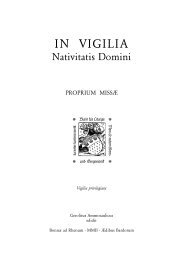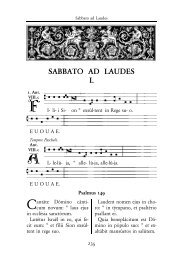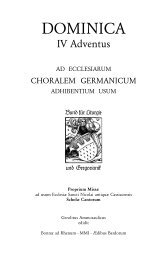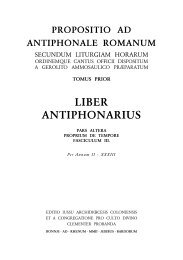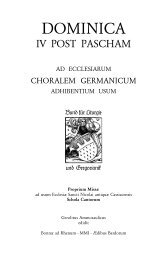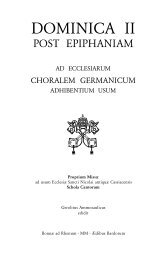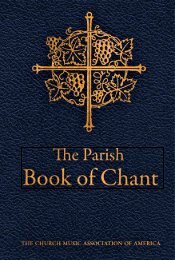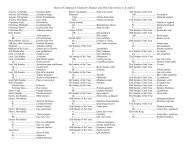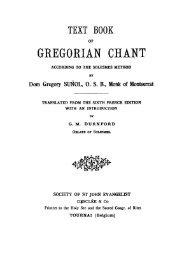The Bugnini-Liturgy and the Reform of the Reform - MusicaSacra
The Bugnini-Liturgy and the Reform of the Reform - MusicaSacra
The Bugnini-Liturgy and the Reform of the Reform - MusicaSacra
Create successful ePaper yourself
Turn your PDF publications into a flip-book with our unique Google optimized e-Paper software.
pers in actual liturgical celebration will know how immensely <strong>the</strong> traditional<br />
structure contributed to <strong>the</strong> effectiveness <strong>of</strong> <strong>the</strong> Hour, which was guided<br />
by liturgical sensitivity to <strong>the</strong> exigencies <strong>of</strong> real life, <strong>and</strong> not by a mechanical<br />
system. This order, which was animated by <strong>the</strong> spirit <strong>of</strong> prayer <strong>and</strong> can only<br />
be understood <strong>and</strong> judged in its life-functions, came into existence through<br />
<strong>the</strong> concatenation <strong>of</strong> logical, <strong>the</strong>ological, psychological <strong>and</strong> artistic forces.<br />
<strong>The</strong> high point <strong>of</strong> <strong>the</strong>se three Hours was <strong>the</strong> canticle from <strong>the</strong> Gospels,<br />
whose dignity derived from its position in <strong>the</strong> New Testament, but whose<br />
text originated in <strong>the</strong> world <strong>of</strong> <strong>the</strong> psalms. Apart from <strong>the</strong> antiphon, it is exactly<br />
<strong>the</strong> uplifting force <strong>of</strong> <strong>the</strong> hymns which assisted <strong>the</strong> community in singing<br />
<strong>the</strong>se words in <strong>the</strong>ir full brilliance, at <strong>the</strong> climax <strong>of</strong> <strong>the</strong> celebration.<br />
From <strong>the</strong> midpoint <strong>of</strong> <strong>the</strong> Hours, i.e., from <strong>the</strong> capitulum onwards <strong>the</strong>re<br />
emerges a "block" (consisting <strong>of</strong> chapter, responsory hymn <strong>and</strong> canticle)<br />
equivalent to <strong>the</strong> "block" <strong>of</strong> psalmody in time <strong>and</strong> significance but, in contrast<br />
to <strong>the</strong> smooth course <strong>of</strong> <strong>the</strong> psalmody, characterized by a steadily increasing<br />
intensity. In opposition to <strong>the</strong> first section <strong>of</strong> <strong>the</strong> Hour which is<br />
primarily accommodated to <strong>the</strong> Old Testament (<strong>and</strong> only in its application,<br />
to <strong>the</strong> New Testament), <strong>the</strong> second section reveals <strong>the</strong> consummation in <strong>the</strong><br />
New Testament more directly.<br />
<strong>The</strong> liturgical truth <strong>of</strong> this structure is even more transparent in <strong>the</strong><br />
Vespers <strong>of</strong> <strong>the</strong> feasts. This Hour commences with <strong>the</strong> tranquillity <strong>of</strong> <strong>the</strong><br />
psalms which contain antiphons enough to attune <strong>the</strong> hearts to <strong>the</strong> feast<br />
<strong>and</strong> to lend intellectual-musical emphasis to <strong>the</strong> psalmody. <strong>The</strong> chapter<br />
takes only one sentence from <strong>the</strong> Scriptures <strong>and</strong> calls attention to it through<br />
its very conciseness (as well as through <strong>the</strong> related visual elements). After<br />
this sentence, a climax is reached: <strong>the</strong> responsory (in fact, prolixum!) raises<br />
us out <strong>of</strong> <strong>the</strong> world <strong>of</strong> <strong>the</strong> psalmody. <strong>The</strong> hymn which follows, lends wings<br />
to <strong>the</strong> Hour in every respect: its five to eight verses provide an excellent<br />
framework within which <strong>the</strong> Church speaks in direct terms about <strong>the</strong> feast,<br />
<strong>and</strong> not merely through <strong>the</strong> words <strong>of</strong> <strong>the</strong> Bible. <strong>The</strong> form <strong>and</strong> <strong>the</strong> poetic<br />
mode <strong>of</strong> expression differentiate this unit from <strong>the</strong> rest <strong>of</strong> <strong>the</strong> liturgy in<br />
a characteristic way. <strong>The</strong> versicle separating <strong>the</strong> hymn from <strong>the</strong> canticle<br />
seems to be well-nigh a composed rest, but it represents as much a momentary<br />
relaxation, as does <strong>the</strong> "letting back" before <strong>the</strong> climax <strong>of</strong> <strong>the</strong> great<br />
musical compositions. <strong>The</strong> emotional <strong>and</strong> thought content accumulated in<br />
<strong>the</strong> hymn <strong>the</strong>n breaks forth in <strong>the</strong> canticle, which though always textually<br />
identical, is always interpreted anew under <strong>the</strong> influence <strong>of</strong> <strong>the</strong> hymn.<br />
16




